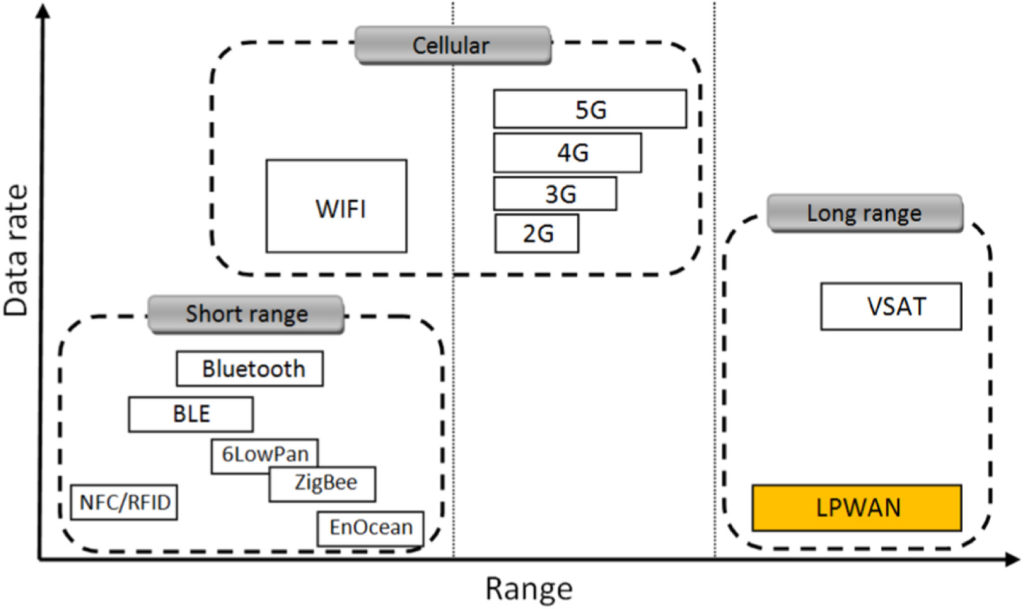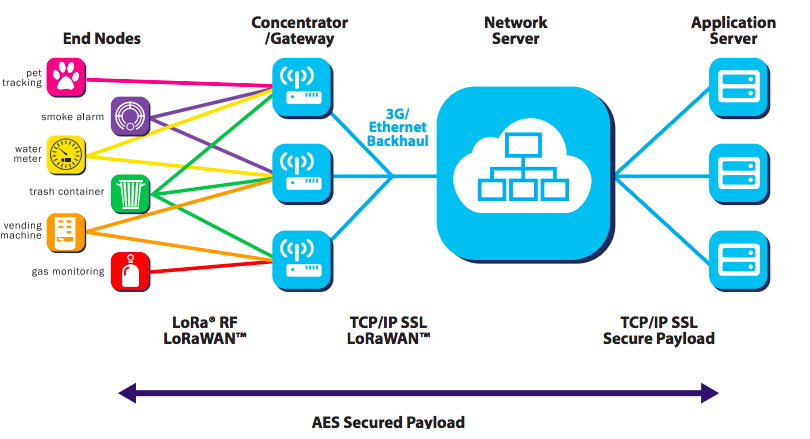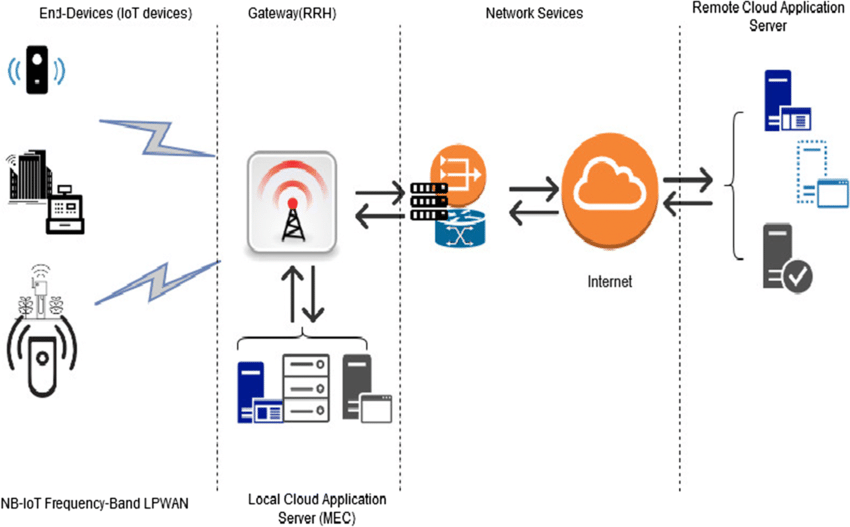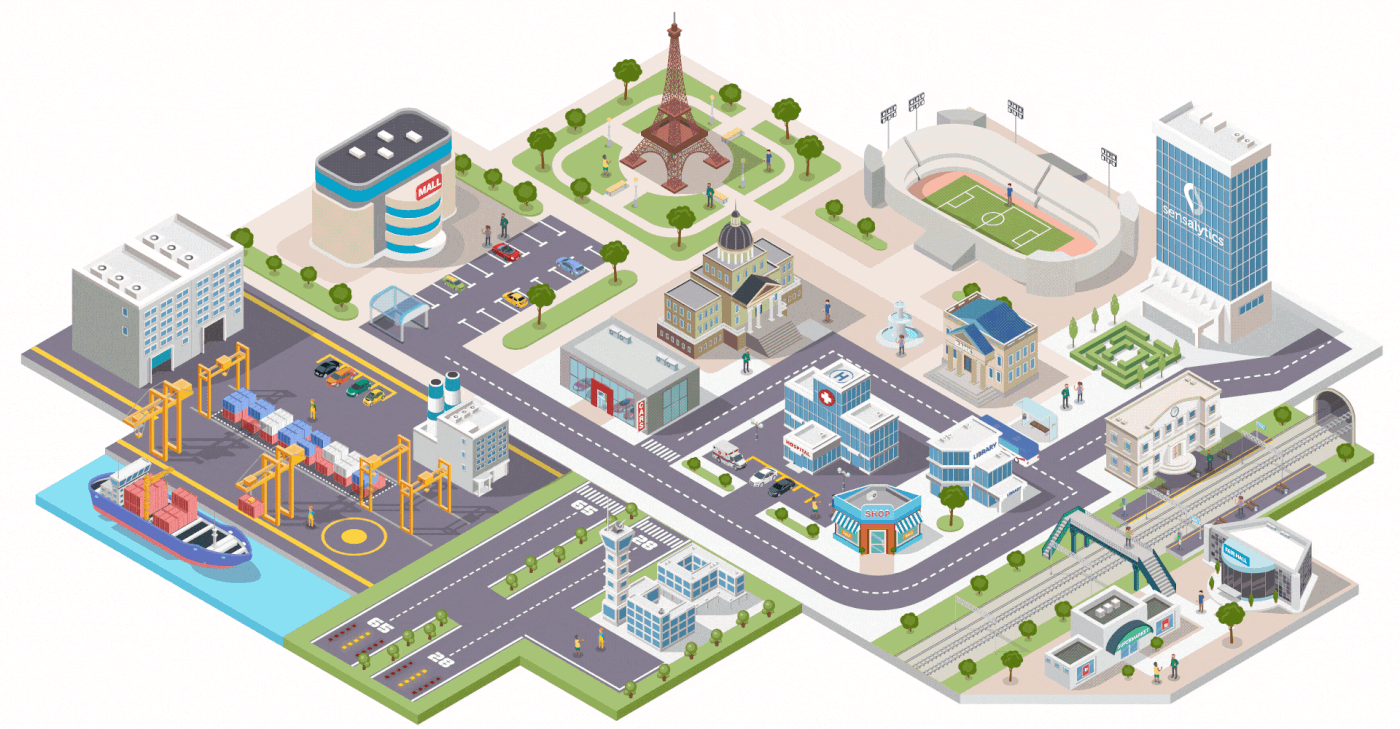Lora and Nb-IoT are the most used and most concerned in the Internet of Things (IoT) application scenarios.
Since 2020, there are new wireless alternatives based on 4G and 5G networks and standardized protocols like NB-IoT. Promises of high speed and heavy workloads are there but LoRaWAN and NB-IoT provide a lot of advantages (and some drawbacks as well). Let’s discover the pros and cons.
Low-Power Wide Area Network (LPWAN)
Most IoT devices, as a smart energy meter, only need to transfer small amounts of data. 3G/4G/5G cellular (or satellite) networks would be expensive and use too much battery power for most devices which are not connected to a power supply but rather battery-powered. Similary, Wi-Fi is too power-consuming. Bluetooth as well and also range-limited.
LPWAN stands for Low-Power Wide Area Network, a wireless network specifically designed to efficiently connect smart devices across long distances, usually through a low bit rate. There are several candidates as LPWAN most-preferred technology but truth is that all meet different requirements.

Let’s talk here about LoRA and NB-IoT which both operate within LPWAN technology. Both standards were developed to improve security, power efficiency and interoperability. They both feature bidirectional communication and are designed to scale well, from a few devices to millions of devices.
LTE-M or Long-Term Evolution (LTE) Machine-type communications is also a candidate introduced by 3GPP. LTE-M technology supports simplified device complexity, low device power consumption, massive connection density and low latency. LTE-M also provides extended coverage and enables the reuse of the LTE installed base. It can operate in 2G, 3G and 4G band, without the need of a gateway. However, LTE-M is more expensive than NB-IoT because several large carriers have patents on the underlying technologies and LTE-M users pay royalties to these companies for their intellectual property.
There are other technologies than LPWAMs for short range connectivity like Bluetooth, ZigBee and WiFi.
For information, Helium is a new kid in the block worth mentioning. It is a startup developing its own open-source LPWAN similar to the LoRaWAN standard; Some interesting applications have been created, for instance things like smart pet collars, smart apartments, and IoT-enabled agriculture farms.
LoRa/LoRaWAN
As its name suggests, LoRaWAN (Long Range Wide Area Network) is a low power, long-ranged WAN. LoRaWAN is used to detect low power signals from long distances. It was designed to connect millions of smart devices having low power and batteries. This protocol is mainly used in smart cities and smart factories.

The LoRa Alliance developed LoRa in 2015 as a secure, energy-efficient IoT standard that makes it easy to onboard new devices. LoRa is shorthand for Long-Range (WAN) and is a modulation technology for LoRaWAN. LoRaWAN is a related set of low-power specifications for IoT devices. LoRa and LoRaWAN are not interchangeable terms; LoRaWAN refers to a LPWAN protocol standard and is not a technology in and of itself. LoRa defines the physical layer. Its security standards emphasize end-to-end encryption, data authentication, and intelligent key derivation, which provides key security features. LoRaWAN is the Media Access Control (MAC) layer protocol on top of the physical layer that defines the communication protocol and system architecture for a device. This is the network upon which all LoRa devices operate.
LoRa is a radio modulation technique. Semtech, a major provider of LoRa devices and services, says the technique is based on chip spread spectrum technology (CSS). LoRa is proprietary. Companies looking to use the technology must purchase LoRa-capable chips (from Semtech for instance).
LoRa’s network architecture uses different regional frequency ranges in the ISM band and SRD band.
In Europe, these include the frequency band from 433.05 MHz to 434.79 MHz and the frequency band from 863 MHz to 870 MHz. In North America, however, the frequency band from 902 MHz to 928 MHz is approved for data transmission. This means that depending on the country where an LoRaWAN-capable IoT is deployed, it will be necessary to choose a LoRa chip or module specific to local frequencies.
A LoRaWAN base station can monitor 8 frequencies with several spreading factors and almost 43 channels. It’s possible to use LoRa without base station in point-to-point or star mode.
LoRa technology has also high sensitivity (-148dBm) and a strong signal-to-noise ratio which provides communication distance up to 15 kilometers. A single LoRa base station can even connect to sensors more than 40 kilometers away in flat rural areas.
LoRaWAN provides different data rates from 250 bps up to 50 kbps (FSK mode) depending of the payload size from 51 bytes to 222 bytes. LoRaWAN can use channels with a bandwidth of either 125 kHz, 250 kHz or 500 kHz, depending on the region or the frequency plan. The spreading factor is chosen by the end-device and influences the time it takes to transmit a frame.
Advantages:
- Long transmission distance (702 km world record!)
- Low working energy consumption so battery can work for several years.
- Multiple and flexible network nodes and multiple nodes can be connected.
- Strong anti-interference with automatic frequency jump and rate adaptation functions.
- Low cost using unlicensed spectrum.
Drawbacks:
- Proprietary technology.
- Need to build a new network, to buy, install and configure LoRaWAN gateways.
- Small payload of byte limit (243 bytes max).
NB-IoT
NB-IoT is an abbreviation for Narrow Band IoT, a cellular standard developed by 3GPP, an umbrella term for a number of standards organizations which develop protocols for mobile telecommunications like GSM, UMTS, LTE and 5G. NB-IoT is not a standalone technology, but a cellular standard that aims to standardize IoT devices to be interoperable and more reliable. It can be implemented in a standalone or in-band spectrum manner and does not require gateways, while each LoRa device needs a LoRaWAN gateway to function (which affects total cost of ownership). NB-IoT connects base stations directly with sensors and your local mobile telco operator.

NB-IoT uses a new physical layer to meet the requirements of extended coverage in rural areas and deep indoors, while enabling very low device complexity. The underlying technology is much less complex than that of GSM/GPRS modules. This technology can coexist along with 2G, 3G and 4G mobile networks.
NB-IoT is not a 5G standard but a 4G technology.
Marketing aficionados often falsely class NB-IoT as 5G technology…
Upload rate is about 20 Kbps
Advantages:
- Ubiquitous coverage and connectivity thanks to 3G/4G existing carrier networks.
- Low power consumption.
- Low cost of devices, which is main topic for huge projects.
- Low working energy consumption so battery can work for several years
- Security much like 4G, including all encryption and SIM-based authentication features.
- High data rates
Drawbacks:
- Dependency with a carrier mobile network/operator
- Connection within a finite environment and only to one network operator (though roaming agreements exist)
- No voice or video transmission despite 3G/4G environment (LoRaWAN is worse!)
- Low interference immunity
Key differences
When it’s time to select LoRa or NB-IoT, all depends on the constraints of the project. Both standards share common key features but each one has its advantages and drawbacks for some specific key features of and IoT project.
Latency
Latency, aka the time delay in transferring data after a transfer request, is probably the key concern and the most important differentiator between LoRa and NB-IoT. Sometimes, data packets don’t need to get transferred immediately, because it sucks up battery power, sometimes, they do because of a ‘real-time’ requirement of the project. A low latency device “checks in” with the network more often than a high latency device. Low latency consumes bandwidth, data volume and energy.
NB-IoT’s lower latency means that it uses battery juice faster than LoRa.
A fire detection smart sensor is typically a low latency sensor : alert and warning must be sent as quickly as possible to the network! In contrast, an air-quality sensor in a street can be a high latency sensor.
Density
LoRa devices use LoRaWAN gateways and don’t need cellular coverage. Consequently they work very well in rural areas or remote industrial facilities. This standard use unlicensed spectrum to communicate. LoRa devices also work well in motion, which makes them well suited for supply chain and transportation applications. LoRa’s geolocation is not GPS-based, so devices offer (geo)location services without impacting too much battery usage.
NB-IoT devices don’t need a specific gateway because they rely on 4G coverage using spectrum within LTE or GSM spectrum. Hence they perform better in indoor applications and dense urban areas. NB-IoT uses GPS technology for geolocation.
Data rates and Payload sizes
NB-IoT boasts much higher data rates than LoRa : max 200 kbps against 50 kbps).
NB-IoT payload is also better : max 1600 bytes against 243 bytes.
How to select?
For most applications and domains, the biggest considerations are latency, battery life, coverage, and cost.
Smart City
LoRa may be the better choice for most smart buildings because of the free placement of gateways. However, buildings have their own electricity supplies: therefore LoRa’s battery efficiency is no more an advantage. Hence, in some cases, NB-IoT may be a better option for a need of very high data throughput or for very low latency.
Thanks to its low cost per device and universal connectivity, NB‑IoT can help control street lighting, determine when trash bins must be emptied, identify free parking spaces, monitor environmental conditions and survey road conditions.
NB-IoT is also likely better for smart city networks that connect dozens or hundreds of buildings, whereas LoRa is better for a single-building application.
Smart Metering
Most smart meters process only low payload of data each day, so LoRa is best for most applications, assuming that the cost of installing a gateway is not prohibitive.
NB-IoT is a good choice for applications that need more frequent communication or high data throughput. Network coverage may also be a major problem as meters are often installed in difficult locations, such as deep underground, in cellars or in remote rural areas. NB‑IoT coverage and penetration are able to address this issue.
Smart Farming
LoRa is the obvious choice for rural areas since it doesn’t require 4G (NB-IoT does). LoRa works particularly well to track agricultural indicators, such as water usage, soil pH and temperature, which don’t shift rapidly or need immediate responses.
Retail and Vending Machines
NB-IoT is definitely the better choice. Retail transactions needs low latency for instant and quick sales.
Supply Chain and Transportation
LoRa mobile gateways may perform reliably on a moving vehicle. Supply chain applications don’t need to transfer much data, so LoRa’s higher latency, lower data rates, and longer battery life fit well. LoRa is also better suited for coverage in rural warehouse areas.
NB-IoT may be suitable for tracking objects that may not be moving all the time.
Manufacturing
Both standards are useful in different environments. It depends on the project requirements and constraints.
NB-IoT may be a better choice for manufacturing applications that need more frequent communication and guaranteed QoS, while LoRa is a better choice for lower-cost sensors and longer battery life.

